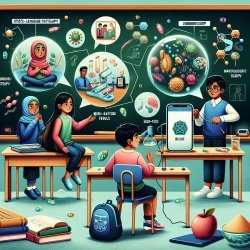Unveiling the Future: Micro and Nano Technologies in Child Therapy
In the realm of speech-language pathology and child therapy, the integration of cutting-edge technologies can be a game-changer. Recent advancements in micro and nano-scale technologies, as discussed in the research article "Micro and Nano-Scale Technologies for Cell Mechanics," offer promising applications that could significantly enhance therapeutic outcomes for children. This blog explores how these technologies can be harnessed to improve therapy services, particularly in online settings provided by companies like TinyEYE.
The Science Behind the Technology
Micro and nano-scale technologies, including BioMEMS (Biological Micro-Electro-Mechanical Systems), have been pivotal in advancing our understanding of cell mechanics. These technologies enable precise manipulation and measurement of cellular properties, providing insights into cellular behavior and interactions. For practitioners in child therapy, these insights can translate into more effective therapeutic strategies, tailored to the unique needs of each child.
Applications in Child Therapy
So, how can these technologies be applied in the context of child therapy?
- Enhanced Diagnostic Tools: BioMEMS devices can offer high-resolution imaging and analysis of cellular structures, aiding in the diagnosis of speech and language disorders. This precision can lead to earlier and more accurate identification of issues, allowing for timely intervention.
- Customized Therapy Plans: Understanding the cellular mechanics of speech and language disorders can inform the development of personalized therapy plans. By tailoring interventions to the specific cellular and molecular characteristics of a child's condition, therapists can improve the efficacy of treatment.
- Real-Time Monitoring: These technologies allow for real-time monitoring of cellular responses to therapy, providing immediate feedback on the effectiveness of interventions. This data-driven approach ensures that therapy is continually optimized to meet the child's evolving needs.
Encouraging Further Research
While the potential of micro and nano technologies in child therapy is immense, it is essential to continue exploring and researching these applications. Practitioners are encouraged to stay informed about the latest developments in cell mechanics and consider how these innovations can be integrated into their practice. Collaborative efforts between researchers and therapists can lead to groundbreaking advancements in therapeutic techniques.
Conclusion
Micro and nano-scale technologies are not just the future; they are the present, offering transformative possibilities for child therapy. By embracing these innovations, practitioners can enhance their skills and provide more effective, personalized care to children. As we continue to explore the intersection of technology and therapy, the potential for improved outcomes is limitless.
To read the original research paper, please follow this link: Micro and Nano-Scale Technologies for Cell Mechanics.










